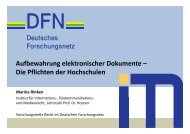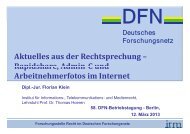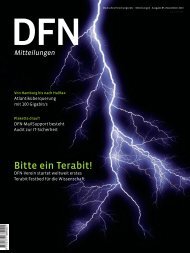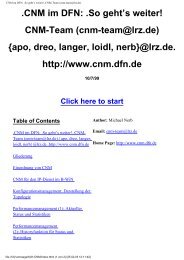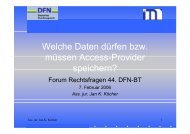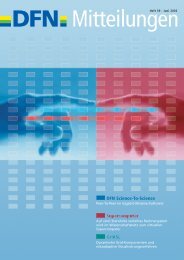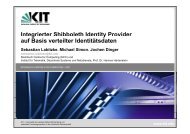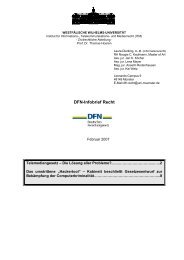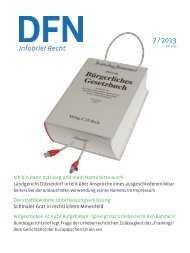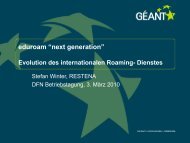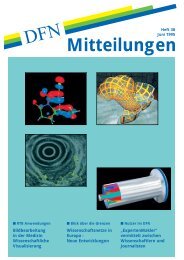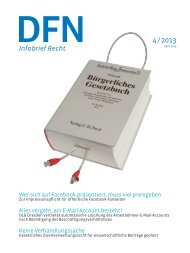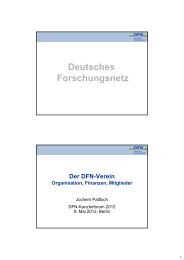X-WiN Confidential - DFN-Verein
X-WiN Confidential - DFN-Verein
X-WiN Confidential - DFN-Verein
Sie wollen auch ein ePaper? Erhöhen Sie die Reichweite Ihrer Titel.
YUMPU macht aus Druck-PDFs automatisch weboptimierte ePaper, die Google liebt.
22 | <strong>DFN</strong> Mitteilungen Ausgabe 84 | Mai 2013 | INTERNATIONAL<br />
for many data-intensive and time-critical research applications.<br />
The upgrade from 2.5 to 10Gb was clearly needed to keep pace<br />
with the increased user demand we are seeing. To illustrate how<br />
capacity to China has grown I may recall that ORIENTplus e–<br />
volved from a direct 2Mbps peering between the UK and China<br />
to a high-speed inter-regional link over a thousand times that<br />
capacity. Not to mention that in <strong>DFN</strong> we celebrated a 64kbps link<br />
between Germany and China less than 15 years ago.<br />
JW: But ORIENTplus is more than just a link with huge capacity.<br />
Thanks to good co-operation between CERNET, TransPAC3,<br />
and Internet2, and ORIENTplus there is now also an integral element<br />
of “around the globe” connectivity support. A recent mutual<br />
back-up agreement between the four partners guarantees<br />
network reliability and resilience by automatically re-routing<br />
the traffic via the US in the event of any outage. I believe this is<br />
the first-ever global back-up partnership and a great example<br />
of collaboration between network providers.<br />
We understand that link is operated in hybrid mode. What are<br />
the advantages of that?<br />
CG: Indeed. The hybrid nature of the link means that it can carry<br />
both IP and point-to-point traffic. It will allow us to deploy tools<br />
and services, such as PerfSONAR, eduroam and dynamic pointto-point<br />
links. In addition to the upgraded link capacity, this will<br />
give us adequate flexibility to support communities with special<br />
networking requirements.<br />
KN: Let us not forget the good team work to make this happen.<br />
We have set up a joint EU-China technical support team. So we<br />
have the most efficient and simplified troubleshooting process<br />
to ensure reliable and high quality network transmission. And I<br />
agree, the hybrid mode provides the opportunity to deploy different,<br />
innovative techniques and equipment, such as acceleration<br />
devices, to match specific application needs.<br />
Who uses this link today and what are the growth areas?<br />
CG: It comes as no surprise that users from the LHC community<br />
were among the first to fill the increased capacity. But we expect<br />
many more from other disciplines. As an interesting effect,<br />
by making the ORIENTplus capacity available to our users we<br />
learned a lot about the many existing collaborations between<br />
European and Chinese researchers.<br />
KN: We have already seen take-up in the field of radio-astronomy.<br />
eVLBI, for example, relies on a stable network connection<br />
*BASNET, CESNET, <strong>DFN</strong>, e-ARENA, GARR, GRNET, JANET, NORDUNET and PSNC<br />
for correlating massive data in real-time from radio-telescopes<br />
in Europe and on CSTNET’s network in China. Similarly, the AR-<br />
GO-YBJ cosmic ray studies involve the transfer of terabytes of<br />
data every year from a telescope in Tibet to a processing centre<br />
in Italy – thousands of miles away. Real-time processing and<br />
analysis of these data do not work with packet loss or a jittery<br />
connection – so the applications need dedicated R&E network<br />
links, such as ORIENTplus, to deliver this. Genomic research between<br />
China and Europe needs the same strong networking. The<br />
commodity Internet would simply not be able to tackle the data<br />
traffic generated by DNA sequencing and processing by life sciences<br />
institutions, such as the Beijing Genomics Institute (BGI)<br />
and the European Bioinformatics Institute (EBI).<br />
JW: More and more collaborative projects between universities<br />
in China and Europe have increasing bandwidth demands. There<br />
are, for example, many UK universities setting up remote campuses<br />
and offices in China, the online courses, videoconferences and<br />
other forms of virtual meetings and discussions are becoming<br />
a key part of this type of remote education. Certainly, ORIENTplus<br />
is the basic infrastructure to support these collaborations.<br />
What special value does China see in ORIENTplus?<br />
JW: In the late 90’s, before ORIENT and ORIENTplus, CERNET’s first<br />
ORIENTplus<br />
Between 2007 and 2010 the ORIENT project provided the<br />
first high capacity link between GÉANT and China with<br />
FP6 funding support and successfully enabled many innovative<br />
EU-China research and application collaborations<br />
to flourish.<br />
ORIENTplus is created to maintain and further develop<br />
infrastructure between GÉANT and China that is open for<br />
use by all European and Chinese researchers. The main focus<br />
of the this project is to support the infrastructure link.<br />
To mark the significant upgrade of the ORIENTplus link to<br />
10 Gbps, project partners, senior EC and Chinese government<br />
officials, media representatives as well as members<br />
of the user community gathered on 12 April for a commemorative<br />
event networked over the ORIENTplus link,<br />
with a main venue in London connected by high-quality<br />
video-conferencing to 14 sites across Europe and China.<br />
The launch event provided an opportunity to hear and see<br />
first-hand from scientists how this high-speed China-EU<br />
link makes a real difference in advancing collaborative<br />
research.



